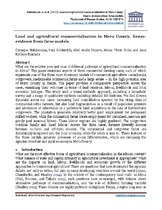| dc.contributor.author | Hakizimana, Cyriaque | |
| dc.contributor.author | Goldsmith, Paul | |
| dc.contributor.author | Nunow, Abdi Aralle | |
| dc.contributor.author | Roba, Adano Wario | |
| dc.contributor.author | Biashara, Jane Kathure | |
| dc.date.accessioned | 2018-10-11T09:27:11Z | |
| dc.date.available | 2018-10-11T09:27:11Z | |
| dc.date.issued | 2017 | |
| dc.identifier.citation | Hakizimana, C. et al. (2017). Land and agricultural commercialisation in Meru County, Kenya: evidence from three models. The Journal of Peasant Studies, 44(3): 555-573. | en_US |
| dc.identifier.issn | 0306-6150 | |
| dc.identifier.uri | http://dx.doi.org/10.1080/03066150.2016.1260555 | |
| dc.identifier.uri | http://hdl.handle.net/10566/4108 | |
| dc.description.abstract | What are the relative pros and cons of different pathways of agricultural commercialisation in Africa? This paper examines aspects of three commercial farming cases, each of which represents one of the three most dominant models of commercial agriculture – small-scale outgrowers, medium-size commercial farms and a large estate – in the high-potential area of Meru County in Kenya. The paper provides a comparative perspective across the cases, examining their outcomes in terms of land relations, labour, livelihoods and local economic linkages. The study used a mixed-methods approach, including a household survey and a range of qualitative methods including detailed life histories. We find diverse dynamics across our cases: increasing land consolidation spurred by the rising class of commercial coffee farmers, but also land fragmentation as a result of population pressure and prevalence of inheritance as a pathway to land acquisition in the case of horticultural outgrowers. The plantation generates relatively better paid employment for permanent skilled workers, while the commercial farms create employment for casualised, insecure and poorly paid seasonal labour. These labour regimes are highly gendered. The outgrowers combine family and hired labour. Across the three cases, farmers diversify income between on-farm and off-farm sources. The commercial and outgrower farms are dynamically integrated into the local economy, while the estate is less so. These features of the three models generate processes of social differentiation, which are reshaping the agrarian structure and rural economy in Meru County. | en_US |
| dc.language.iso | en | en_US |
| dc.publisher | Taylor & Francis | en_US |
| dc.rights | This is the author-version of the article published online at: http://dx.doi.org/10.1080/03066150.2016.1260555 | |
| dc.subject | Agricultural commercialisations | en_US |
| dc.subject | Land | en_US |
| dc.subject | Labour | en_US |
| dc.subject | Livelihoods | en_US |
| dc.subject | Economic linkages | en_US |
| dc.subject | Meru County | en_US |
| dc.subject | Kenya | en_US |
| dc.title | Land and agricultural commercialisation in Meru County, Kenya: evidence from three models | en_US |
| dc.type | Article | en_US |
| dc.privacy.showsubmitter | FALSE | |
| dc.status.ispeerreviewed | TRUE | |
| dc.description.accreditation | ISI | |

